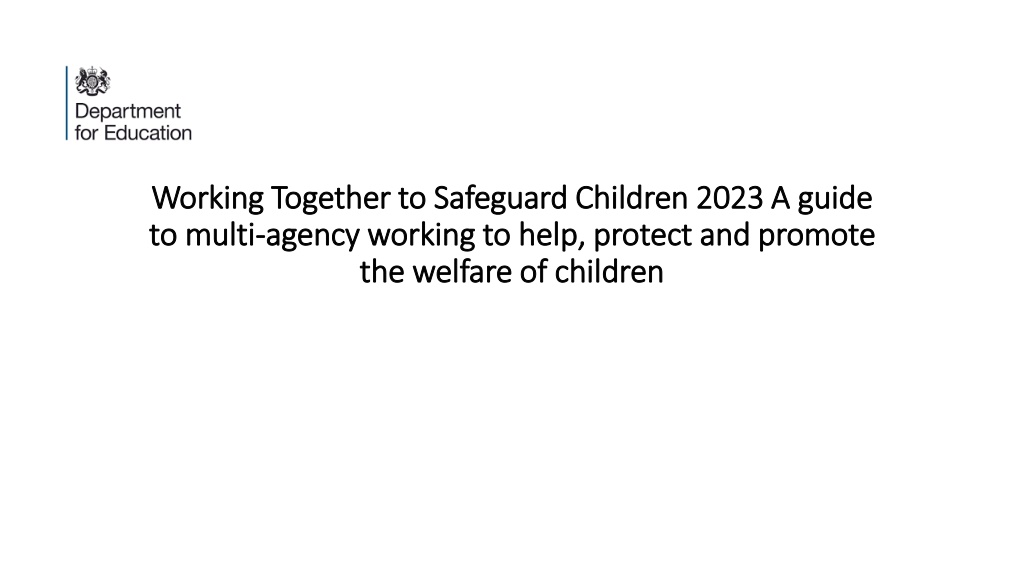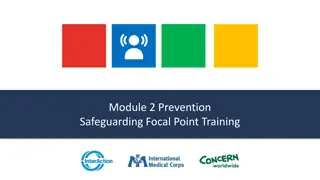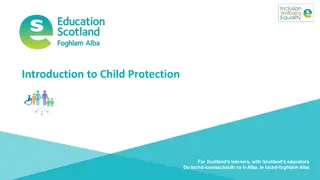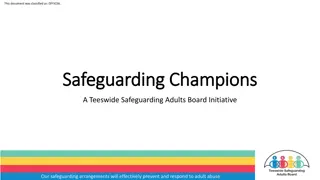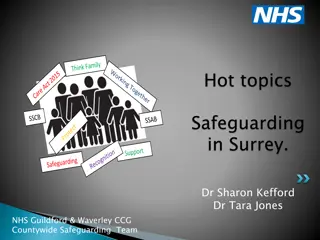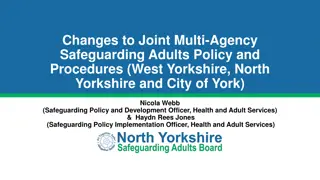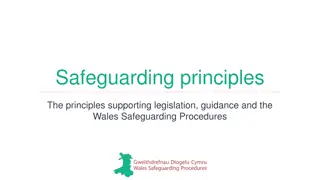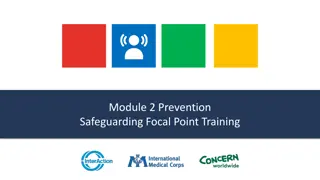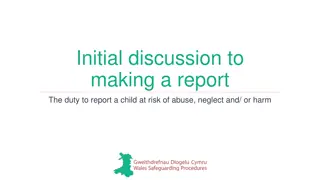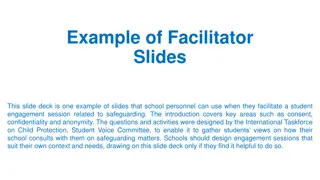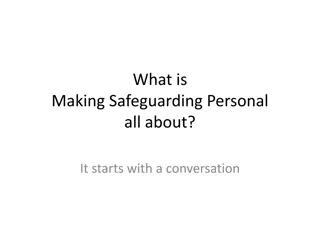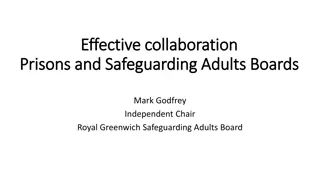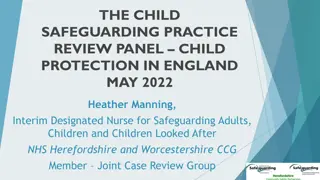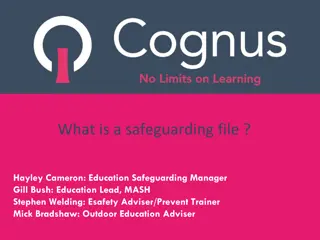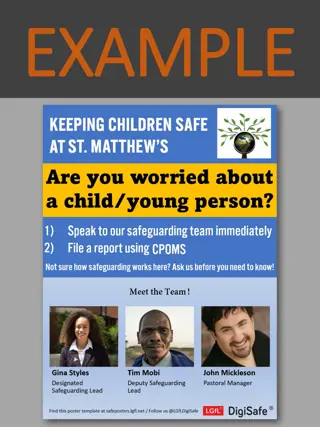Enhancing Child Safeguarding Practices in 2023
The guide "Working Together to Safeguard Children 2023" introduces new principles and expectations for multi-agency collaboration to enhance the welfare of children. It emphasizes shared responsibility among safeguarding partners, strengthens multi-agency safeguarding arrangements, clarifies organizational responsibilities, and emphasizes learning from serious child safeguarding incidents and child death reviews.
- Child Safeguarding
- Multi-Agency Collaboration
- Welfare of Children
- Safeguarding Partners
- Organizational Responsibilities
Download Presentation

Please find below an Image/Link to download the presentation.
The content on the website is provided AS IS for your information and personal use only. It may not be sold, licensed, or shared on other websites without obtaining consent from the author. Download presentation by click this link. If you encounter any issues during the download, it is possible that the publisher has removed the file from their server.
E N D
Presentation Transcript
Working Together to Safeguard Children 2023 A guide Working Together to Safeguard Children 2023 A guide to multi to multi- -agency working to help, protect and promote agency working to help, protect and promote the welfare of children the welfare of children
Working Together To Safeguard Children 2023 Working Together To Safeguard Children 2023 Children s Social Care National Framework and Dashboard Children s Social Care National Framework and Dashboard Kinship Care Strategy Kinship Care Strategy Data Strategy Data Strategy Information Sharing Guidance Information Sharing Guidance - - 2024 2024
Working Together to Safeguard Children 2023 changes introduces principles for working with parents and carers, sets expectations for multi-agency working that apply to all individuals, agencies and organisations Chapter 1 - A Shared Responsibility: strengthens how safeguarding partners work together and with relevant agencies clarifies roles and responsibilities of safeguarding partners and introduces the partnership chair role emphasises the role of education, and engaging VCSE orgs and sports clubs in local arrangements strengthening accountability around information sharing, independent scrutiny, funding, and reporting Chapter 2 - Multi- agency safeguarding arrangements: strengthens the role of education and childcare settings in supporting children and keeping them safe improves family network engagement in decision making and supporting children clarifies a broader range of practitioners working with children and families under section 17 clarifies support for disabled children and their families, children in mother and baby units (in prisons) and children at risk from people in prison and people supervised by the probation service introduces new national multi-agency child protection standards clarifies the multi-agency response to all forms of abuse and exploitation from outside the home Chapter 3 - Providing help, support and protection: Chapter 4 - Organisational responsibilities: factual changes to align with legislation and guidance; Prison and Probation sections highlights the mutual benefits of exchanging information with children s social care Chapter 5 - Learning from serious child safeguarding incidents: clarifying the expectation for local authorities to keep in touch with care leavers over the age of 21, and the non- mandatory reporting of care leaver deaths up to age 25. Chapter 6 - Child Death Reviews: factual changes to align with legislation, statutory and operational guidance published since 2018.
Working Together 2023: A Shared Responsibility We have introduced a new chapter at the beginning of Working Together to emphasise that successful outcomes for children depend on strong multi-agency partnership working across the whole system of help, support and protection and effective work from all agencies with parents, carers and families Renaming the statutory guidance to reflect the help and support that is provided to families: The intention is to centre the importance of providing help for parents and families, and the need for decisive action when children need protection from harm, alongside the Children Act 1989 duties on all individuals, organisations and agencies to safeguard and promote the welfare of children. Introducing practice principles for working with parents and carers: We have drafted clear, explicit expectations for how all agencies and practitioners should work with parents and carers so that they understand what is happening and can engage with services in a meaningful way. Information about key decision-making points will support parents to understand the change that is expected to keep their child safe. These new principles are drawn from good practice that already exists in local areas. Introducing expectations for effective multi-agency working at a strategic, management and direct practice level: Numerous reviews, including those from the Child Safeguarding Practice Review Panel, have identified the need for much improved multi-agency working with more robust critical thinking and challenge within and between agencies. We have developed expectations to underpin this multi-agency working in the following five areas: Collaboration; Learning; Resourcing; Inclusion; Mutual Challenge OFFICIAL SENSITIVE: NOT GOVERNMENT POLICY 4
What this means for you Multi-agency expectations Introduced to underpin multi-agency working by focussing on collaboration, learning, resourcing, inclusion, and mutual challenge. Apply to all individuals, agencies and organisations. In place for those working at strategic level through to direct practice. Multi-agency safeguarding arrangements Clarified the roles and responsibilities of safeguarding partners, and how they work together. Changes also provide for more accountability for how leaders and services make a difference. Strengthened the role of relevant agencies, including education settings at a strategic level. Principles for working with parents and carers New set of principles (drawn from good practice) to strengthen expectations of howpractitioners work with parents and carers. Bring consistency in the way families receive help and support, children are protected and practitioners across agencies develop effective and meaningful relationships with parents and carers. Child protection standards New set of national multi-agency practice standards for child protection that emphasise the skills, experience, and expertise practitioners working in a multi-agency child protection context need. Apply to all practitioners who come into contact with children where there is concern that the child is suffering or likely to suffer significant harm..
Overview: Multi Agency Safeguarding Arrangements Chapter 2 on Multi-Agency Safeguarding Arrangements focuses on strengthening how safeguarding partners (local authorities, integrated care boards and the police) work together, and with relevant agencies, to safeguard and protect children locally. Protecting children from abuse and neglect is a multi-agency endeavour and one which requires join up and cooperation at all levels. Clarifying roles and responsibilities, including distinguishing between lead safeguarding partners and their delegates: We have distinguished those responsible for setting the vision and priorities (Lead Safeguarding Partners) and those leading delivery of arrangements (Delegate Safeguarding Partners), outlining the joint functions as strategic leaders for the first time. Introducing a partnership chair: It is envisaged that this individual will replace the need for an independent chair and allow a single point of escalation for risks and issues to the Lead Safeguarding Partners. Role of relevant agencies and education providers: We have emphasised the role of education in safeguarding arrangements, reflecting the importance they play in children s lives and the value in involving them in strategic decision-making. Strengthening Working Together is the first step before exploring whether further legislative changes are needed. Role of voluntary, charity, social enterprise (VCSE) organisations and sports clubs: We have highlighted the importance of considering naming and engaging these organisations in published local arrangements if they are not already. Accountability and transparency: We have provided more detail on key functions such as independent scrutiny, funding arrangements, dispute resolution and reporting; introducing for the first time a set date by which local areas should submit their yearly reports to encourage greater transparency and compliance. 6 OFFICIAL SENSITIVE: NOT GOVERNMENT POLICY
Working Together 2023: Help and support for children and their families We want children and their families to receive the right help at the right time, from practitioners with the right knowledge, skills and relationships working with families to keep children safe and well. We also want a renewed focus on family-led solutions where other family members and family friends can play an invaluable role in supporting parents, enabling children to live safely at home. Early help strengthened the focus on families for improving outcomes, the role of education and childcare settings in supporting children and keeping them safe and further considerations for practitioners when identifying a child who may need early help services Family Networks - a renewed focus on family-led solutions from within a family network . With family networks engaged at the earliest point and at every stage. We have outlined the components of family group conferences to improve family network engagement in decision making and supporting children. Direct work with children under s17 of the CA1989 clarifying that a broader range of practitioners can lead direct work with children and their families where support is provided under section 17 of the Children Act 1989 (Child in Need). Clarifying that social worker qualified practice supervisors or managers provide oversight for key decisions and activity, and that where child protection enquiries are made under section 47 of the Children Act 1989, the lead practitioner should be a social worker. Support for disabled children and families. We want a stronger focus on support and protection for disabled children, to provide non-stigmatising help and support to disabled children and their families. Strengthening the language around the role of the Designated Social Care Officer, to align with the wider reforms to the SEND system. Support for children in mother and baby units. We have clarified the role of children s social care in the assessment of suitability and social work input for a mother and baby unit placement within a prison estate. Protecting children from prisoners who present an ongoing risk from within custody or whilst on probation. We have clarified the role and responsibilities prison and probation services have in keeping children safe and how children s social care should work in partnership to ensure effective child safeguarding and protection is provided. 7 OFFICIAL SENSITIVE: NOT GOVERNMENT POLICY
Working Together 2023: Decisive Multi-Agency Child Protection Our vision for child protection is an effective multi-agency system where practitioners across agencies have the highest levels of knowledge and skills, and work in an integrated way across statutory child protection activities. Guidance for working with children and their families across the whole system of help, support and protection. This chapter outlines how agencies, organisations and individuals work together through early help, targeted early help, through statutory support under section 17 of the Children Act 1989 and through child protection enquires under section 47 of the same Act . National multi-agency child protection standards: Set out the actions, considerations and behaviours that should lead to improved child protection practice and better outcomes for children. Apply to all individuals from every agency involved in child protection practice Harm outside the home: We have strengthened and clarified the multi-agency safeguarding response to all forms of abuse and exploitation, and provision under section 17 and section 47 of the Children Act 1989. Outlining key considerations for practitioners to understand the extra- familial context and the role of partners in keeping children safe and working in partnership with parents. OFFICIAL SENSITIVE: NOT GOVERNMENT POLICY 8
MULTI-AGENCY SAFEGUARDING ARRANGEMENTS LEAD Safeguarding Partners Local Authority Chief Executive Chief Officer of Police ICB Chief Executive Partnership (DSP agreed by Lead SPs INDEPENDENT SCRUTINY PARTNERSHIP CHAIR Education Representative ICB Police Local Authority DELEGATE Safeguarding Partners Executive Lead for Children Place based no lower than Area Commander, Head of Public Protection Director of Children's Services Relevant Agencies Business Manager & Business support function Sub-groups as agreed by partners
Lead Safeguarding Partners Lead Safeguarding Partners Assure themselves that their local arrangements are effective and keep children safe. This includes systems of assurance and accountability within each of their organisations, including inspection findings LSPs are jointly responsible for ensuring the proper involvement of and oversight of all relevant agencies, and should act as a team and should meet sufficiently regularly - where the boundaries of the police and ICB extend over multiple local authority areas LSPs may decide to meet at a more regional level Set the strategic direction, vision, and culture of the local safeguarding arrangements, including agreeing and reviewing shared priorities and the resource required to deliver services effectively Lead their organisation s individual contribution to the shared priorities, ensuring strong governance, accountability, and reporting mechanisms to hold their delegates to account for the delivery of agency commitments
Review and sign off key partnership documents: published multi-agency safeguarding arrangements, including plans for independent scrutiny, shared annual budget, yearly report, and local threshold document Provide shared oversight of learning from independent scrutiny, serious incidents, local child safeguarding practice reviews, and national reviews, ensuring recommendations are implemented and have a demonstrable impact on practice (as set out in the yearly report) Ensure multi-agency arrangements have the necessary level of business support, including intelligence and analytical functions, such as an agreed data set providing oversight and a robust understanding of practice Ensure all relevant agencies, including education settings, are clear on their role and contribution to multi- agency safeguarding arrangements
Delegated Safeguarding Partners Delegated Safeguarding Partners DSPs should be sufficiently senior to be able to speak with authority, take decisions on behalf of the LSP and hold their sectors to account DSPs should meet sufficiently frequently Oversight of the quality and compliance of the delivery of agreed shared priorities Processes in place to provide assurance that multi-agency practice is reviewed and operating well DSPs and LSPs should have regular interaction and communication Delivery and monitoring of multi-agency priorities and procedures to protect and safeguard children in the local area, in compliance with published arrangements and thresholds
Close partnership working and engagement with education (at strategic and operational level) and other relevant agencies, allowing better identification of and response to harm The implementation of effective information sharing arrangements between agencies, including data sharing that facilitates joint analysis between partner agencies Delivery of high-quality and timely rapid reviews and local child safeguarding practice reviews, with the impact of learning from local and national reviews and independent scrutiny clearly evidenced in yearly reports The provision of appropriate multi-agency safeguarding professional development and training Seeking of, and responding to, feedback from children and families about their experiences of services and co-designing services to ensure children from different communities and groups can access the help and protection they need
Partnership Chair Partnership Chair To develop strategic links, support and hold to account all LSPs in fulfilling their safeguarding duties for children Ensure that local arrangements are designed to work collaboratively and effectively by encouraging and supporting the development of partnership working between the LSPs, DSPs, independent scrutiny role and MASA subgroups Chair the meetings of the DSPs, including any additional meetings convened as a response to specific and exceptional circumstances, with the help of the business manager and independent scrutiny role Offer appropriate challenge to ensure that the partners are accountable, and that the local arrangements operate effectively Provide greater continuity across local areas and act as the conduit between the DSPs and LSPs, providing feedback and escalating collective risk and issues to LSPs as necessary
Independent Scrutiny Independent Scrutiny An independent person must review the effectiveness of the multi-agency safeguarding arrangements the system in place should lead to objective and rigorous analysis Provide safeguarding partners and relevant agencies with independent, rigorous, and effective support and challenge at both a strategic and operational level Provide assurance to the whole system in judging the effectiveness of the multiagency safeguarding arrangements through a range of scrutiny methods Ensure that statutory duties are being fulfilled, quality assurance mechanisms are in place, and that local child safeguarding practice reviews and national reviews are analysed, with key learning areas identified and effectively implemented across the safeguarding system
Ensure that the voice of children and families is considered as part of scrutiny and that this is at the heart of arrangements through direct feedback, informing policy and practice Be regarded as a critical friend and provide opportunities for two-way discussion and reflection between frontline practitioners and leaders. This will encourage and enable strong, clear, strategic leadership Provide independent advice when there are disagreements between agencies and safeguarding partners and facilitate escalation procedures Evaluate and contribute to multi-agency safeguarding published arrangements and the annual report, alongside feeding into the wider accountability systems such as inspections Scrutiny work can be undertaken through interviews, focus groups, data analysis, observations, and peer review. Scrutiny should take account of the voice and experience of children and their families
What are you expected to do now? What are you expected to do now? Name a specific LSP and DSP for each partner agency and include their details in your annual report and published arrangements Agree how often they will meet and, if necessary, develop new governance arrangements Name the Partnership Chair from the DSP group and agree how the Chair role will be shared Consider the role of education partners and strengthen if necessary Review the funding arrangements and consider how they will become more equitable If present in the structure, remove the role of Independent Chair Review your arrangements for Independent Scrutiny to ensure the functions of the role are covered Update your annual report and publish by September 24 for financial year 23/24 Publish your new arrangements by December 24 Review your current arrangements (health check tool available) to ensure effective practice is being delivered as set out in: New multi-agency expectations New principles for working with parents and carers New Multi-agency child protection standards 17
